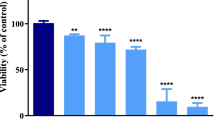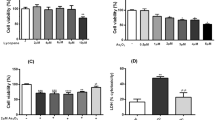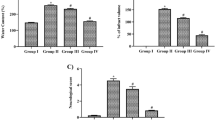Abstract
Sesquiterpenes have attracted much interest with respect to their protective effect against oxidative damage that may be the cause of many diseases including several neurodegenerative disorders and cancer. Our previous unpublished work suggested that cyclosativene (CSV), a tetracyclic sesquiterpene, has antioxidant and anticarcinogenic features. However, little is known about the effects of CSV on oxidative stress induced neurotoxicity. We used hydrogen peroxide (H2O2) exposure for 6 h to model oxidative stress. Therefore, this experimental design allowed us to explore the neuroprotective potential of CSV in H2O2-induced toxicity in new-born rat cerebral cortex cell cultures for the first time. For this aim, MTT and lactate dehydrogenase release assays were carried out to evaluate cytotoxicity. Total antioxidant capacity (TAC) and total oxidative stress (TOS) parameters were used to evaluate oxidative changes. In addition to determining of 8-hydroxy-2-deoxyguanosine (8-OH-dG) levels, the single cell gel electrophoresis (or Comet assay) was also performed for measuring the resistance of neuronal DNA to H2O2-induced challenge. Our results showed that survival and TAC levels of the cells decreased, while TOS, 8-OH-dG levels and the mean values of the total scores of cells showing DNA damage (Comet assay) increased in the H2O2 alone treated cultures. But pre-treatment of CSV suppressed the cytotoxicity, genotoxicity and oxidative stress which were increased by H2O2. On the basis of these observations, it is suggested that CSV as a natural product with an antioxidant capacity in mitigating oxidative injuries in the field of neurodegenerative disorders.






Similar content being viewed by others
References
Abdel-Wahab BA, Metwally ME (2011) Ginkgo biloba enhances the anticonvulsant and neuroprotective effects of sodium valproate against kainic acid-induced seizures in mice. J Pharmacol Toxicol 6:679–690
Abolaji AO, Eteng MU, Omonua O, Adenrele Y (2013) Influence of coadministration of artemether and lumefantrine on selected plasma biochemical and erythrocyte oxidative stress indices in female Wistar rats. Hum Exp Toxicol 32:206–215
Afoulous S, Ferhout H, Raoelison EG, Valentin A, Moukarzel B, Couderc F, Bouajila J (2013) Chemical composition and anticancer, antiinflammatory, antioxidant and antimalarial activities of leaves essential oil of Cedrelopsis grevei. Food Chem Toxicol 56:352–362
Avalos Funez A, Isabel Haza A, Mateo D, Morales P (2013) In vitro evaluation of silver nanoparticles on human tumoral and normal cells. Toxicol Mech Methods 23:153–160
Ban JY, Jeon SY, Nguyen TT, Bae K, Song KS, Seong YH (2006) Neuroprotective effect of oxyresveratrol from smilacis chinae rhizome on amyloid Beta protein (25–35)-induced neurotoxicity in cultured rat cortical neurons. Biol Pharm Bull 29:2419–2424
Beck JJ, Smith L, Merrill GB (2008) In situ volatile collection, analysis, and comparison of three Centaurea species and their relationship to biocontrol with herbivorous insects. J Agric Food Chem 56:2759–2764
Cacciatore I, Baldassarre L, Fornasari E, Cornacchia C, Di Stefano A, Sozio P, Cerasa LS, Fontana A, Fulle S, Di Filippo ES, La Rovere RM, Pinnen F (2012) (R)-α-lipoyl-glycyl-l-prolyl-l-glutamyl dimethyl ester codrug as a multifunctional agent with potential neuroprotective activities. Chem Med Chem 7:2021–2029
Chen X, Zhang Q, Cheng Q, Ding F (2009) Protective effect of salidroside against H2O2-induced cell apoptosis in primary culture of rat hippocampal neurons. Mol Cell Biochem 32:85–93
Crutwell-McFadyen RE (1998) Biological control of weeds. Annu Rev Entmol 43:369–393
Davis ME, Croteau R (2000) Cyclization enzymes in the biosynthesis of monoterpenes, sesquiterpenes, and diterpenes topics in current. Top Curr Chem 209:54–92
Di Stefano A, Sozio P, Cerasa LS, Iannitelli A, Cataldi A, Zara S, Giorgioni G, Nasuti C (2010) Ibuprofen and lipoic acid diamide as co-drug with neuroprotective activity: pharmacological properties and effects in β-amyloid (1–40) infused Alzheimer’s disease rat model. Int J Immunopath Ph 23:589–599
Dirican E, Turkez H, Togar B (2012) Modulatory effects of Thymbra spicata L. different extracts against the mercury induced genotoxicity in human lymphocytes in vitro. Cytotechnology 64:181–186
Droge W (2002) Free radicals in the physiological control of cell function. Physiol Rev 82:47–95
Farah R, Khamisy-Farah R, Amit T, Youdim MB, Arraf Z (2013) Lithium’s gene expression profile, relevance to neuroprotection A cDNA microarray study. Cell Mol Neurobiol 33:411–420
Gan LS, Zheng YL, Mo JX, Liu X, Li XH, Zhou CX (2009) Sesquiterpene lactones from the root tubers of Lindera aggregata. J Nat Prod 72:1497–1501
Geyikoglu F, Turkez H (2005a) Protective effect of sodium selenite on genotoxicity to human whole blood cultures induced by aflatoxin B-1. Brazil Arch Biol Technol 48:905–910
Geyikoglu F, Turkez H (2005b) Genotoxicity and oxidative stress induced by some bismuth compounds in human blood cells in vitro. Fresenius Environ Bull 14:854–860
Hassan HA, Hafez HS, Goda MS (2013) Mentha piperita as a pivotal neuro-protective agent against gamma irradiation induced DNA fragmentation and apoptosis: mentha extract as a neuroprotective against gamma irradiation. Cytotechnology 65:145–156
Hou RC, Huang HM, Tzen JT, Jeng KC (2003) Protective effects of sesamin and sesamolin on hypoxic neuronal and PC12 cells. J Neurosci Res 74:123–133
Iizuka Y, Hong S, Kim CY, Yang WI, Lee JE, Seong GJ (2010) Protective mechanism of agmatine pre-treatment on RGC-5 cells injured by oxidative stress. Braz J Med Biol Res 43:356–358
Isobe C, Abe T, Terayama Y (2010) Levels of reduced and oxidized coenzyme Q-10 and 8-hydroxy-2′- deoxyguanosine in the CSF of patients with Alzheimer’s disease demonstrate that mitochondrial oxidative damage and/or oxidative DNA damage contributes to the neurodegenerative process. J Neurol 257:399–404
Jain V, Baitharu I, Barhwal K, Prasad D, Singh SB, Ilavazhagan G (2012) Enriched environment prevents hypobaric hypoxia induced neurodegeneration and is independent of antioxidant signaling. Cell Mol Neurobiol 32:599–611
Jiang B, Liu JH, Bao Y, An LJ (2003) Hydrogen peroxide-induced apoptosis in PC12 cells and the protective effect of puerarin. Cell Biol Int 27:1025–1031
Kang SM, Cha SH, Ko JY, Kang MC, Kim D, Heo SJ, Kim JS, Heu MS, Kim YT, Jung WK, Jeon YJ (2012) Neuroprotective effects of phlorotannins isolated from a brown alga, Ecklonia cava, against H2O2- induced oxidative stress in murine hippocampal HT22 cells. Environ Toxicol Pharmacol 34:96–105
Karpińska A, Gromadzka G (2013) Oxidative stress and natural antioxidant mechanisms: the role in neurodegeneration. From molecular mechanisms to therapeutic strategies. Postepy Hig Med Dosw 67:43–53
Khan R, Sultana S (2011) Farnesol attenuates 1,2-dimethylhydrazine induced oxidative stress, inflammation and apoptotic responses in the colon of Wistar rats. Chem Biol Interact 192:193–200
Kikuchi Y, Yasuhara T, Agari T, Kondo A, Kuramoto S, Kameda M, Kadota T, Baba T, Tajiri N, Wang F, Tayra JT, Liang H, Miyoshi Y, Borlongan CV, Date I (2011) Urinary 8-OHdG elevations in a partial lesion rat model of Parkinson’s disease correlate with behavioral symptoms and nigrostriatal dopaminergic depletion. J Cell Physiol 226:1390–1398
Kumar KH, Khanum F (2013) Hydroalcoholic extract of Cyperus rotundus ameliorates H2O2-induced human neuronal cell damage via its anti-oxidative and anti-apoptotic machinery. Cell Mol Neurobiol 33:5–17
Kundu A, Saha S, Walia S, Shakil NA, Kumar J, Annapurna K (2013) Cadinene sesquiterpenes from Eupatorium adenophorum and their antifungal activity. J Environ Sci Health B 48:516–522
Liu T, Hu HT, Sun QR (2010) Neuroprotective effects of emodin on primary rat cortical neurons apoptosis induced by hydrogen peroxide. Zhong Yao Cai 33:1116–1119
Lodewyk MW, Gutta P, Tantillo DJ (2008) Computational studies on biosynthetic carbocation rearrangements leading to sativene, cyclosativene, alpha-ylangene, and beta-ylangene. J Org Chem 73:6570–6579
Lorenzo Y, Costa S, Collins AR, Azqueta A (2013) The comet assay, DNA damage, DNA repair and cytotoxicity: hedgehogs are not always dead. Mutagenesis 28:427–432
Maynard S, Schurman SH, Harboe C, de Souza-Pinto NC, Bohr VA (2009) Base excision repair of oxidative DNA damage and association with cancer and aging. Carcinogenesis 30:2–10
McCarthy JJ, Saith S, Linnertz C, Burke JR, Hulette CM, Welsh-Bohmer KA, Chiba-Falek O (2012) The Alzheimer’s associated 5′ region of the SORL1 gene cis regulates SORL1 transcripts expression. Neurobiol Aging 33: 1485.e1-8
Mehri S, Abnous K, Mousavi SH, Shariaty VM, Hosseinzadeh H (2012) Neuroprotective effect of crocin on acrylamide-induced cytotoxicity in PC12 cells. Cell Mol Neurobiol 32:227–235
Moslehi M, Meshkini A, Yazdanparast R (2012) Flavonoid baicalein modulates H2O2-induced mitogenactivated protein kinases activation and cell death in SK-N-MC cells. Cell Mol Neurobiol 32:549–560
Nabavi SF, Nabavi SM, Habtemariam S, Moghaddam AH, Sureda A, Mirzaei M (2013) Neuroprotective effects of methyl-3-O-methyl gallate against sodium fluoride-induced oxidative stress in the brain of rats. Cell Mol Neurobiol 33:261–267
Olmez I, Ozyurt H (2012) Reactive oxygen species and ischemic cerebrovascular disease. Neurochem Int 60:208–212
Pala S, Gurkan H (2008) The role of free radicals in ethiopathogenesis of diseases. Adv Mol Biol 1:1–9
Panieri E, Gogvadze V, Norberg E, Venkatesh R, Orrenius S, Zhivotovsky B (2013) Reactive oxygen species generated in different compartments induce cell death, survival, or senescence. Free Radic Biol Med 57:176–187
Scalcinati G, Partow S, Siewers V, Schalk M, Daviet L, Nielsen J (2012) Combined metabolic engineering of precursor and co-factor supply to increase α-santalene production by Saccharomyces cerevisiae. Microb Cell Fact 11:117
Shin HT, Chung SH, Lee JS, Kim SS, Shin HD, Jang MH, Shin MC, Bahn GH, Paik EK, Park JH, Kim CJ (2003) Protective effect of shenqi-wan against H2O2-induced apoptosis in hippocampal neuronal cells. Am J Chin Med 31:675–686
Si CL, Shen T, Jiang YY, Wu L, Yu GJ, Ren XD, Xu GH, Hu WC (2013). Antioxidant properties and neuroprotective effects of isocampneoside II on hydrogen peroxide-induced oxidative injury in PC12 cells. Food Chem Toxicol 59:145–152
Silva FM, Marques A, Chaveiro A (2010) Reactive oxygen species: a double-edged sword in reproduction. Open Vet Sci J 4:127–133
Sinclair D, Donegan S, Isbar, Lalloo DG (2012) Artesunate versus quinine for treating severe malaria. Cochrane Database Syst Rev 6:CD005967
Singh NP, McCoy MT, Tice RR, Schneider EL (1988) A simple technique for quantitation of low levels of DNA damage in individual cells. Exp Cell Res 175:184–191
Sozio P, D’Aurizio E, Iannitelli A, Cataldi A, Zara S, Cantalamessa F, Nasuti C, Di Stefano A (2010) Ibuprofen and lipoic acid diamides as potential codrugs with neuroprotective activity. Arch Pharm 343:133–142
Sozio P, Cerasa LS, Laserra S, Cacciatore I, Cornacchia C, Di Filippo ES, Fulle S, Fontana A, Di Crescenzo A, Grilli M, Marchi M, Di Stefano A (2013) Memantine-sulfur containing antioxidant conjugates as potential prodrugs to improve the treatment of Alzheimer’s disease. Eur J Pharm Sci 49:187–198
Stefanova N, Georgievska B, Eriksson H, Poewe W, Wenning GK (2012) Myeloperoxidase inhibition ameliorates multiple system atrophy-like degeneration in a transgenic mouse model. Neurotox Res 21:393–404
Sumathi T, Shobana C, Christinal J, Anusha C (2012) Protective effect of Bacopa monniera on methyl mercuryinduced oxidative stress in cerebellum of rats. Cell Mol Neurobiol 32:979–987
Suntrup S, Teismann I, Bejer J, Suttrup I, Winkels M, Mehler D, Pantev C, Dziewas R, Warnecke T (2013) Evidence for adaptive cortical changes in swallowing in Parkinson’s disease. Brain 36:726–738
Tang LL, Wang R, Tang XC (2005) Huperzine A protects SHSY5Y neuroblastoma cells against oxidative stress damage via nerve growth factor production. Eur J Pharmacol 519:9–15
Thannickal VJ, Fanburg BL (2000) Reactive oxygen species in cell signaling. Am J Physiol Lung Cell Mol Physiol 279:1005–1028
Togar B (2013) The cytological, biochemical and genetic effects of selected sesquiterpenes on healthy neuron and N2a neuroblastoma cell cultures. PhD’s thesis, Atatürk University, Gradute School of Natural and Applied Sciences, Department of Biology, Erzurum, Turkey
Turkez H (2011) The role of ascorbic acid on titanium dioxide-induced genetic damage assessed by the comet assay and cytogenetic tests. Exp Toxicol Pathol 63:453–457
Turkez H, Togar B (2010) The genotoxic and oxidative damage potential of olanzapine in vitro. Toxicol Ind Health 26:583–588
Turkez H, Sozio P, Geyikoglu F, Tatar A, Hacimuftuoglu A, Di Stefano A (2013) Neuroprotective effects of farnesene against hydrogen peroxide-induced neurotoxicity in vitro. Cell Mol Neurobiol. doi:10.1007/s10571-013-9991-y
Turrens JF (2003) Mitochondrial formation of reactive oxygen species. J Physiol 552:335–344
Umemura K, Itoh T, Hamada N, Fujita Y, Akao Y, Nozawa Y, Matsuura N, Iinuma M, Ito M (2008) Preconditioning by sesquiterpene lactone enhances H2O2-induced Nrf2/ARE activation. Biochem Biophys Res Commun 368:948–954
Vlasova IA, Zakharova IO, Sokolova TV, Avrova NF (2013) Metabolic effects of ganglioside GM1 on PC12 cells at oxidative stress depend on modulation of activity of tyrosine kinase of trk receptor. Zh Evol Biokhim Fiziol 49:15–23
Wang H, Wang Y, Liu P, Wang W, Fan Y, Zhu W (2013) Purpurides B and C, two new sesquiterpene esters from the aciduric fungus Penicillium purpurogenum JS03-21. Chem Biodivers 10:1185–1192
Zhang Q, Huang WD, Lv XY, Yang YM (2012) Puerarin protects differentiated PC12 cells from H2O2-induced apoptosis through the PI3 K/Akt signalling pathway. Cell Biol Int 36:419–426
Acknowledgments
We are grateful to our lab specialists for their help and efforts in experiments done in the pharmacology laboratories and animal housing.
Conflict of interest
The authors declare that there are no conflicts of interest.
Author information
Authors and Affiliations
Corresponding author
Rights and permissions
About this article
Cite this article
Turkez, H., Togar, B., Di Stefano, A. et al. Protective effects of cyclosativene on H2O2-induced injury in cultured rat primary cerebral cortex cells. Cytotechnology 67, 299–309 (2015). https://doi.org/10.1007/s10616-013-9685-9
Received:
Accepted:
Published:
Issue Date:
DOI: https://doi.org/10.1007/s10616-013-9685-9




